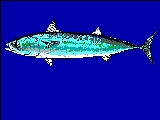
Bullet tuna
Encyclopedia
The bullet tuna, Auxis rochei rochei, is a subspecies
of tuna
, in the family
Scombridae
, found circumglobally in tropical oceans in open surface waters
to depths of 50m (164 ft). Its maximum length is 50.0 cm.
The bullet tuna is a comparatively small and slender tuna. It has a triangular first dorsal fin
, widely separated from the second dorsal fin, which, like the anal and pectoral fins, is relatively small. There are the usual finlets
of the tuna. There is a small corselet of small scale
s around the pectoral region of the body.
Bullet tunas are blue-black on the back with a pattern of zig-zag dark markings on the upper hind body, and silver below. The fins are dark grey.
They feed on small fish, squid
, planktonic crustacean
s, and stomatopod larva
e.
Subspecies
Subspecies in biological classification, is either a taxonomic rank subordinate to species, ora taxonomic unit in that rank . A subspecies cannot be recognized in isolation: a species will either be recognized as having no subspecies at all or two or more, never just one...
of tuna
Tuna
Tuna is a salt water fish from the family Scombridae, mostly in the genus Thunnus. Tuna are fast swimmers, and some species are capable of speeds of . Unlike most fish, which have white flesh, the muscle tissue of tuna ranges from pink to dark red. The red coloration derives from myoglobin, an...
, in the family
Family (biology)
In biological classification, family is* a taxonomic rank. Other well-known ranks are life, domain, kingdom, phylum, class, order, genus, and species, with family fitting between order and genus. As for the other well-known ranks, there is the option of an immediately lower rank, indicated by the...
Scombridae
Scombridae
Scombridae is the family of the mackerels, tunas, and bonitos, and thus includes many of the most important and familiar food fishes. The family consists of about 55 species in 15 genera and two subfamilies...
, found circumglobally in tropical oceans in open surface waters
Photic zone
The photic zone or euphotic zone is the depth of the water in a lake or ocean that is exposed to sufficient sunlight for photosynthesis to occur...
to depths of 50m (164 ft). Its maximum length is 50.0 cm.
The bullet tuna is a comparatively small and slender tuna. It has a triangular first dorsal fin
Dorsal fin
A dorsal fin is a fin located on the backs of various unrelated marine and freshwater vertebrates, including most fishes, marine mammals , and the ichthyosaurs...
, widely separated from the second dorsal fin, which, like the anal and pectoral fins, is relatively small. There are the usual finlets
Fish anatomy
Fish anatomy is primarily governed by the physical characteristics of water, which is much denser than air, holds a relatively small amount of dissolved oxygen, and absorbs more light than air does.- Body :...
of the tuna. There is a small corselet of small scale
Scale (zoology)
In most biological nomenclature, a scale is a small rigid plate that grows out of an animal's skin to provide protection. In lepidopteran species, scales are plates on the surface of the insect wing, and provide coloration...
s around the pectoral region of the body.
Bullet tunas are blue-black on the back with a pattern of zig-zag dark markings on the upper hind body, and silver below. The fins are dark grey.
They feed on small fish, squid
Squid
Squid are cephalopods of the order Teuthida, which comprises around 300 species. Like all other cephalopods, squid have a distinct head, bilateral symmetry, a mantle, and arms. Squid, like cuttlefish, have eight arms arranged in pairs and two, usually longer, tentacles...
, planktonic crustacean
Crustacean
Crustaceans form a very large group of arthropods, usually treated as a subphylum, which includes such familiar animals as crabs, lobsters, crayfish, shrimp, krill and barnacles. The 50,000 described species range in size from Stygotantulus stocki at , to the Japanese spider crab with a leg span...
s, and stomatopod larva
Larva
A larva is a distinct juvenile form many animals undergo before metamorphosis into adults. Animals with indirect development such as insects, amphibians, or cnidarians typically have a larval phase of their life cycle...
e.

